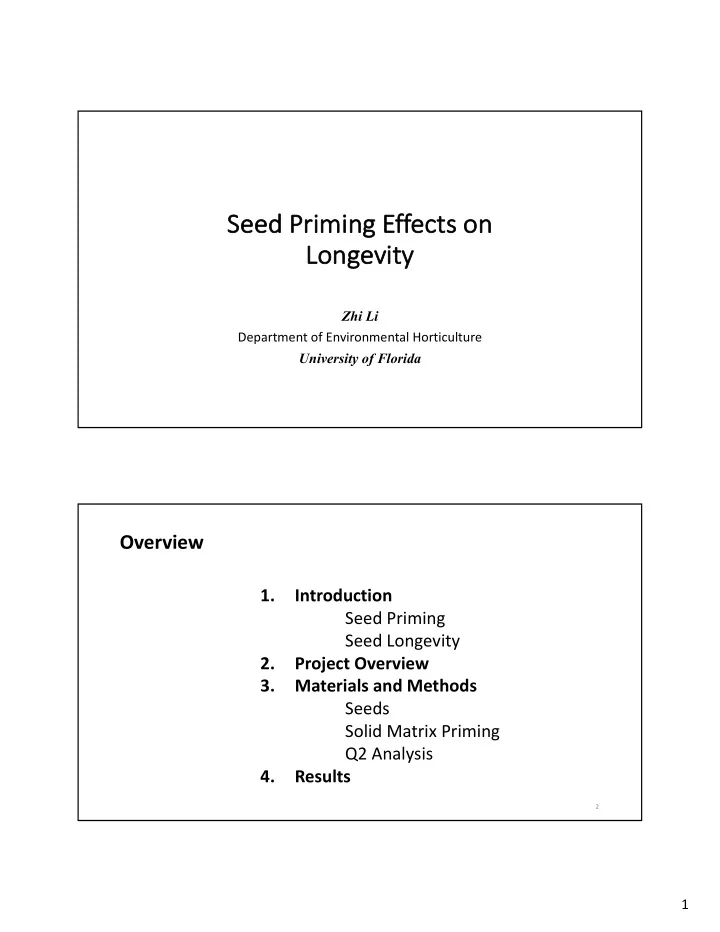

Se Seed Prim imin ing g Effects on on Longevit Lo vity Zhi Li Department of Environmental Horticulture University of Florida Overview 1. Introduction Seed Priming Seed Longevity 2. Project Overview 3. Materials and Methods Seeds Solid Matrix Priming Q2 Analysis 4. Results 2 1
Seed Priming Methods: Ø Hydropriming Ø Osmopriming Ø Solid Matrix Priming Ø etc. Lutts, Stanley, et al . "Seed Priming: New Comprehensive Approaches for an Old Empirical Technique." (2016). 3 Se Seed P Prim imin ing Effects of priming: Factors affect priming: • Increase germination rate • Temperature and uniformity • Develop seedling root • Water potential systems rapidly • Break dormancy, • Priming duration overcome some adverse conditions, e.g. high “Hydrothermal priming time” Model temperature • Reduce seed longevity, especially at high moisture content 2
Seed Longevity after priming Lettuce Seeds Controlled Deterioration @ 10% MC + 40C Osmopriming @ -1.5 MPa Water Incubation Water treatments and priming affect seed longevity. control control Reduction of seed longevity in storage compared priming to non-primed seed Water treatment Tarquis, A.M. and Bradford, K.J. (1992) Prehydration and priming treatments that advance germination also in- crease the rate of deterioration of lettuce seeds. Journal of Experimental Botany 5 Project Design – Activities performed Germination Tests Prescreening Priming Objective: Priming Tests MC Tests Develop and evaluate priming treatments on Drying with seed longevity Drying Beads to 30% RH Incubation at 47% RH Controlled Deterioration Tests Q2 Tests 3
Materials and Methods Seeds Seeds were obtained from HM.Clause company, including: • Two seed lots of tomato (cv. Pony Express E89224 (T1) and E57272 (T2)) • One seed lot of pepper (cv. Sequoia Pepper E65965) • One seed lot of onion (cv. Mission Star E46851). Materials and Methods Solid Matrix Priming + fixed amount of seeds and increasing amount of water to obtain threshold seed water content for priming. Ratio seed : media : water range 1 : 2 : 1 - 2 Clay mixture material A.G. Taylor, D.E. Klein and T.H. Whitlow (1988) SMP: Solid Matrix Priming of Seeds. Scientia Horticulturae, 37 Keith Kubick – HM-Clause 4
Materials and Methods Q2 Q2 Oxygen Se Sensing Technology The Q2 equipment provides a quick and precise measurement of the oxygen consumption of each individual seed, so that it can give us respiration (oxygen depletion) time courses. http://www.astec-global.com/q2-technology Materials and Methods Q2 Analysis oxygen consumption Agar 0.4% + Fungicide measurements at 30-minute intervals Curves of O 2 depletion 10 5
Materials and Methods Population Oxygen Depletion (POD) Curves • POD curves are visually similar to germination time courses . Seed oxygen consumption rates on an individual seed • and population basis are highly correlated with germination timing. • Potential maixumum longevity(Pmax) of seeds can be estimated aging-time model based on POD data. Bello, P., and Bradford, K.J. (2016). Single-seed oxygen consumption measurements and population- based threshold models link respiration and germination rates under diverse conditions. Seed Science Research 26, 199-221. 11 Results Final Germination : Onion 85% Tomato-T1 94% Tomato-T2 94% Pepper 85% Initial seed germination at 25C. 12 6
Results - Prescreening of Priming Days for germination 2.5g of seed + 5g of clay media + different amount of water. Amount of days required to start of germination adding increasing amount of water on bags (2.5-4.75ml). 3ml chosen for priming on all species. 13 Project Design – Activities performed Germination Tests Prescreening Priming Priming Tests Controlled Deterioration Test: MC Tests 50°C with different aging durations, Drying with ranging from 10-40 Days Drying Beads to 30% RH Q2 Test: Incubation at Population Oxygen Depletion (POD) 47% RH Curves Controlled Deterioration Tests Q2 Tests 7
Results – Priming Duration Pepper – little change in rates for first 4 days of priming, increasing speed after that. Pepper Onion Onion – more gradual reduction in time with increasing priming duration. Tomato-T1 – Similar gradual response except with longest duration. Tomato-T2 – 1 and 2 days Tomato – T1 Tomato – T2 duration response strong as longer priming duration. Figure .Population Oxygen Depletion (POD) curves for pepper (A), onion (B), tomato-T1 (C) and tomato-T2 (D) with different days of priming (legends in each panel). The curves are plotted for R50 (the times at which each seed consumed half of the oxygen available in the Q2 vial). 15 Results – Controlled Deterioration Tomato - T1 200 70 A B Tomato T1 60 160 50 R50(50) (h) Pmax (days) 120 40 30 80 20 40 Priming duration (days) 10 0 1 2 4 6 0 0 0 1 2 4 6 0 10 20 30 40 Aging duration (days) Priming Duration (days) Longevity declined sharply between 0 and 2 days of priming, then recovered somewhat at longer priming times. 8
Results – Controlled Deterioration Tomato-T2 250 90 Tomato - T2 - Priming Duration and Aging Tomato - T2 - Priming Duration and Pmax 80 200 70 Pmax (days) 60 150 R50(50) 50 Tomato – T2 – Priming 40 durations + Aging Series - 100 30 Q2 Tests 20 50 10 0 1 2 3 4 5 6 0 0 0 1 2 3 4 5 6 0 10 20 30 40 Priming Duration (days) Aging duration (days) Similar pattern to T1, with the least potential longevity occurring after 2 days of priming 17 Take-home Messages Performance enhanced by priming: • Increase germination rate and uniformity • Develop seedling root systems rapidly • Break dormancy, overcome some adverse conditions Disadvantage: • Reduce seed longevity 9
Recommend
More recommend